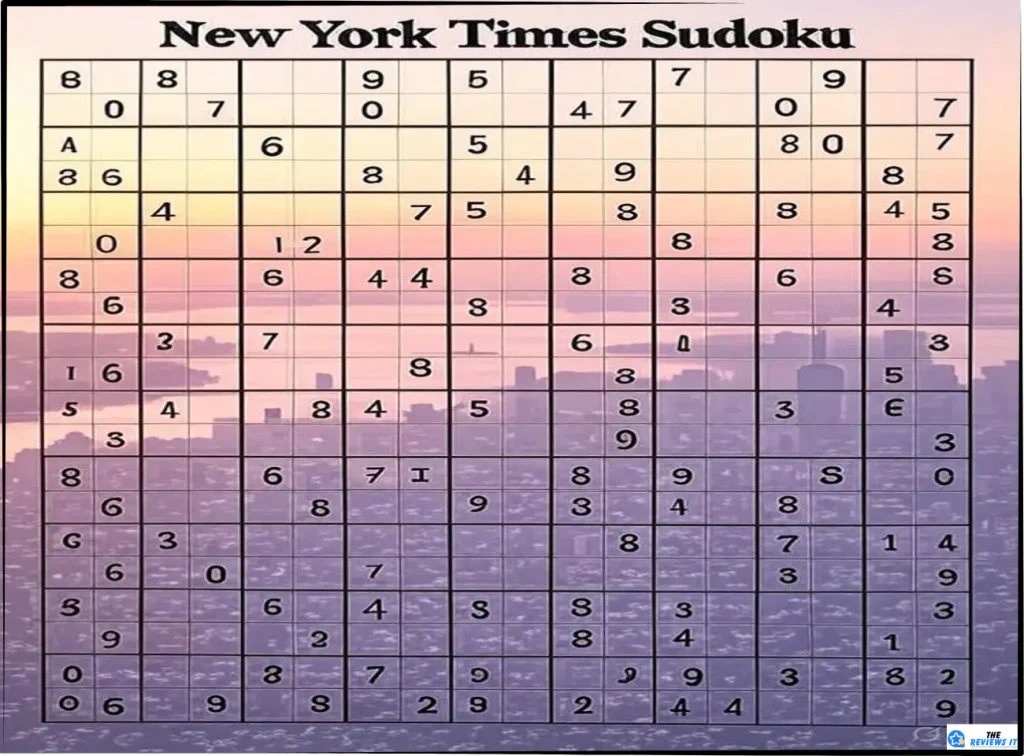Sudoku is loved by people all over the world, and the New York Times has made it even more fun and easy to play. It’s a daily number puzzle that tests your logic and gives you a fresh challenge every day.
There are three difficulty levels easy, medium, and hard, so both beginners and experts can enjoy it. This article will cover the game’s history, how it works, its main features, and tips to solve puzzles faster.
It will also answer questions like, “Why is New York Times Sudoku special?” and “How can you improve your solving skills?” From its origins to the way it works online today, we’ll also look at why the hard level is a top choice for experienced players.
What Is New York Times Sudoku?
New York Times Sudoku is a daily puzzle available on nytimes.com/puzzles/sudoku, the NYT Games app, and the Play section of the New York Times News app. It features a 9×9 grid divided into nine smaller 3×3 boxes.
Players must fill the grid so each row, column, and box contains the numbers 1–9 without repeats. Some numbers, called “givens,” are provided as clues, and the rest must be solved using logic.
The game is free to play, with a subscription unlocking extra features like access to past puzzles. New puzzles are released every day at 10 p.m. EST from Tuesday to Saturday and at 6 p.m. EST on Sunday and Monday.
Players can choose from three difficulty levels: easy, medium, and hard, making it a popular choice for both beginners and seasoned puzzle fans.
| Difficulty | Description | Time |
| Easy | Many pre-filled cells, simple logic | 5-10 min |
| Medium | Fewer clues, moderate logic | 10-20 min |
| Hard | Minimal clues, advanced strategies | 20-40+ min |
The History Of Sudoku And Its Play In The New York Times
Origins In The 1700s: Sudoku’s roots trace back to the 18th century when Swiss mathematician Leonhard Euler created “Latin Squares,” a grid-based puzzle where symbols could not repeat.
Modern Sudoku creation: The version we know today was developed by American architect Howard Garns in 1979 and first published in Dell Pencil Puzzles and Word Games as “Number Place.”
Popularity In Japan: In 1984, the puzzle became a hit in Japan, where it was renamed “Sudoku,” short for a phrase meaning “the numbers are limited to one time.”
Global Rise In The 2000s: By the early 2000s, Sudoku had become a worldwide trend, appearing in newspapers, books, and online platforms.
Introduction To The New York Times: The New York Times added Sudoku in 2004, following other U.S. papers, and quickly gained a loyal audience through its “Sudoku – New York Times Number Puzzles” series.
Easy-To-Learn Gameplay: Sudoku requires no math skills, only logic, making it accessible to players of all ages, with simple rules that can be learned in minutes.
Fast Growth In Popularity: A 2005 New York Times article noted Sudoku’s rapid rise, comparing it to the crossword craze of the 1920s, with some readers buying multiple papers for extra puzzles.
High-Quality Puzzle Design: The New York Times ensured each Sudoku was computer-generated with only one correct solution and offered in varying difficulty levels same as play gimkit host, setting it apart from many competitors.
How To Play New York Times Games Sudoku?

The New York Times Sudoku is a 9×9 puzzle where some numbers are already given. Your goal is to fill in the rest so each row, column, and 3×3 box contains numbers 1–9 without repeats. It’s all about logic, and solving it is both fun and satisfying.
This is how it works, and solving it gives players a great feeling when they complete it correctly.
Access: Play on nytimes.com, the NYT Games app, or the NYT News app. No subscription is needed for daily puzzles, but subscribers can access an archive.
Difficulty Levels: Choose from New York Times Sudoku easy, medium, or hard. Easy puzzles have more givens (around 30–35), making them quicker to solve. Medium puzzles (20–30 givens) require more deduction, while New York Times Sudoku hard puzzles (fewer than 20 givens) demand advanced strategies.
Modes: Use Normal Mode to enter confirmed numbers or Candidate Mode to note possible numbers for a cell. Toggle between modes via the app’s interface or by pressing the spacebar on the website.
Features: A timer tracks solving time, an undo button reverses mistakes, and a “Hint” option highlights the next solvable cell. Incorrect entries are marked with a red dot, and players can switch to Dark Mode for a light-on-dark display.
If you enjoy free, easy-to-access online games like Sudoku, you might also want to check out Hypackel, a popular platform offering a wide variety of free browser games for school, work, or fun.
Why Is The New York Times Daily Sudoku Very Famous?
What sets the New York Times daily Sudoku apart from other versions? Several unique features make it a favorite:
- Fresh Puzzles Daily: Unlike some platforms that recycle puzzles, the NYT offers a new grid every day, ensuring variety. The puzzles increase in difficulty throughout the week, with Mondays being the easiest and Saturdays often the toughest.
- Balanced Difficulty: The three levels—easy, medium, and hard—cater to all skill levels. New York Times Sudoku medium puzzles strike a balance, challenging beginners while preparing them for New York Times Sudoku hard challenges.
- User-Friendly Interface: The NYT Games app and website offer tools like Candidate Mode, which lets players jot down possible numbers, and Auto Candidate Mode, which suggests options for beginners. The interface is clean, with options to print puzzles in PDF format for offline solving.
- Community and Competition: The NYT fosters a sense of community through its puzzles. While there’s no official scoreboard, players often share their solving times on platforms like Reddit, where the sudoku subreddit discusses NYT puzzles, with users reporting times like 3–4 minutes for easy, 15–20 minutes for medium, and 20–45 minutes for hard puzzles.
The NYT’s puzzles are designed to be engaging yet accessible, appealing to both casual solvers and dedicated enthusiasts. As one Reddit user noted, the NYT’s hard puzzles rarely require techniques beyond hidden pairs or triples, making them challenging but solvable with practice.
Visit Top 20 Flixtor Alternatives To Watch Latest Fun Shows For Free

Strategies For Solving Sudoku – New York Times Number Puzzles
Mastering Sudoku – New York Times Number Puzzles – The New York Times requires logical reasoning and pattern recognition. Here are key strategies, drawing from expert advice like that of Thomas Snyder, a three-time World Sudoku Championship winner:
- Scan for Obvious Placements: Start by identifying cells with only one possible number. For example, if a 3×3 box has numbers 1–8, the missing 9 must go in the empty cell. This is especially effective in the New York Times’ easy Sudoku puzzles.
- Use Pencil Marks (Candidate Mode): In Candidate Mode, note possible numbers for each cell. For instance, if a cell in a row can only be 3 or 7, mark both. As you fill in other cells, eliminate options to narrow it down.
- Look for Locked Candidates: If a number can only fit in one row or column within a 3×3 box, it’s “locked” there, eliminating it from other cells in that row or column. This is useful in New York Times medium Sudoku puzzles.
- Identify Hidden Pairs or Triples: In hard Sudoku New York Times puzzles, look for two or three cells in a row, column, or box that can only contain specific numbers. For example, if two cells in a row can only be 4 or 8, eliminate other numbers from those cells.
- Take Breaks: If stuck, step away briefly. As Snyder suggests, a short break can help you spot patterns you missed. This is especially true for New York Times hard Sudoku puzzles, where complex patterns can be elusive.
For the Sudoku New York Times hard puzzles, solvers may need advanced techniques like “X-Wing” (where two rows or columns limit a number’s placement) or “Swordfish” (a pattern involving three rows or columns).
Explore BestTarahi.com Ultimate Hub For Games, Gear, & Real Gadgets
However, Reddit users note that NYT hard puzzles rarely require such complexity, making them accessible yet challenging. Interestingly, the New York Times Sudoku runs exceptionally well on high-performance devices like the Honor Magic 5 Pro—if you’re curious about its features, you can check out the full review in this geekzilla tech honor magic 5 pro article.
Tips For Beginners In The New York Times Easy Sudoku
If you are new to Sudoku, you can start with New York Times Sudoku easy puzzles, which have more givens to guide you. Here are beginner-friendly tips:
- Focus On High-Frequency Numbers: Look for numbers that appear frequently in the grid. If 7 appears in several rows, identify where it’s missing in others.
- Divide The Grid Mentally: Break the 9×9 grid into three rows and three columns of 3×3 boxes. Check each section for missing numbers to spot easy placements.
- Avoid Guessing: Unlike some puzzles, Sudoku has one solution. Guessing can lead to errors, so rely on logic. If you’re unsure, use Candidate Mode to track possibilities.
- Practice Regularly: Solving daily puzzles builds pattern recognition. As one Reddit user shared, their time dropped from 50 minutes to under 20 minutes for hard puzzles after a week of practice.
The NYT’s easy puzzles are forgiving, often solvable in 3–5 minutes, making them ideal for learning the ropes.
Hard Challenges Of New York Times Sudoku?
New York Times hard Sudoku Puzzle push solvers to their limits with fewer givens and intricate patterns. These puzzles, often taking 20–45 minutes, require patience and advanced logic. Common challenges include:
- Sparse Grids: With fewer than 20 givens, solvers must rely on deduction rather than obvious placements.
- Complex Patterns: Techniques like hidden triples or locked candidates are often needed, as noted by Reddit users who find NYT hard puzzles “moderately difficult” compared to other platforms.
- Time Pressure: While the NYT timer is optional, many solvers feel the urge to beat their personal best, adding pressure. A Reddit user reported a personal record of 15 minutes for a hard puzzle, calling it “abnormally easy.”
Despite these challenges, the satisfaction of cracking a hard puzzle is immense, as solvers experience the “aha” moment when a pattern clicks. One notable example is Streamer Sketch, which gained popularity for showcasing streamers who played and solved these types of intricate puzzle games, often capturing that exact moment of breakthrough on screen.
The Community & Culture Of NYT Sudoku Solvers
sudoku – new york times number puzzles — The New York Times has a huge active community:
Active Community On Reddit: Fans gather in the r/sudoku subreddit to discuss solving strategies, share completion times, and ask for help with difficult puzzles.
Average Solving Times: Medium puzzles usually take 15–20 minutes, while hard puzzles take 20–30 minutes for experienced players.
Special Events: The New York Times sometimes hosts major events like the World Sudoku and Puzzle Championships, where top players compete.
Unique Competition Traditions: Players often bring quirky items like pencils, earplugs, or stuffed toys for good luck during competitions.
Global Connection: Even without official scoreboards or rankings, the daily puzzle fosters a sense of belonging among players worldwide.
Reddit Users Share Why They Love It
Many Reddit users praise The New York Times Sudoku for its clean design, daily puzzle updates, and range of difficulty levels. Players like that it works well on both desktop and mobile, making it easy to play anywhere.
Some enjoy starting their day with the medium puzzles for a quick challenge, while others love testing themselves on the hard ones. A few users mention that the interface is smooth and free from unnecessary distractions, which keeps the focus on solving.
Overall, the community sees it as a reliable and enjoyable way to sharpen their minds while having fun.
| Pros | Cons |
| Accessible on multiple devices | No offline play |
| Clean and user-friendly design | Hard levels |
Conclusion
New York Times Sudoku is a daily favorite for millions. It combines thinking, patience, and the fun of solving puzzles. Its roots go back to the 1700s with “Latin Squares,” which later became the Sudoku we know today.
The NYT version is special because it’s easy to use and well-designed. Whether you’re trying medium puzzles as a beginner or solving hard ones as an expert, there’s something for everyone.
With a simple layout, fresh puzzles every day, and a large community of players, it keeps people coming back. Pick up a pencil or play on your phone and start playing today.
FAQS
Is New York Times Sudoku Free?
Yes, you can play a few puzzles for free each day. A subscription gives unlimited access.
Can I Play On My Phone?
Yes, it’s available on the NYT Games app and website.
Are There Different Difficulty Levels?
Yes, you can choose from easy, medium, and hard puzzles.
Do I Need An Account To Play?
No, but having an account lets you save progress and play across devices.









